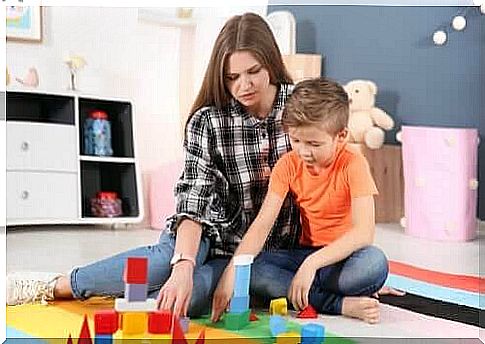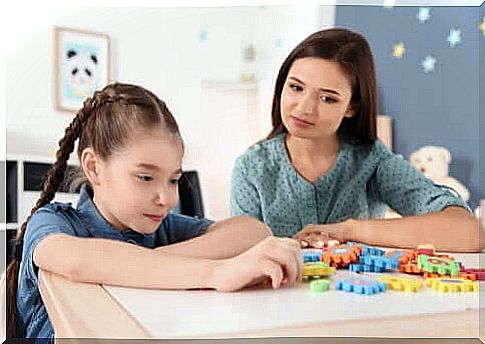Psychological Treatment For Autism

Today, there are various treatments that both children and adults on the autism spectrum can try. Some of them have a robust scientific basis and show results, but others are not as successful or may only work with people who fit a very specific profile. On the other hand, we know that effective psychological treatment for autism is based on evidence and is both integrative and holistic.
The Austrian psychiatrist Leo Kanner was the first to formally recognize autism in the 1940s. Kanner studied traits commonly found in autism, such as isolation, language problems, limited communication, or obsession with stable environments.
The exact definition of autism is still controversial today. Since a few years ago , people use the term “autism spectrum disorder (ASD)” to classify a larger group of disorders that have clinical features that define “classic” autism.
Autism affects 10 to 15 users in 10,000. When you include other conditions such as Asperger’s syndrome, the prevalence reaches up to 57 out of every 10,000.
In terms of gender prevalence, 4 out of every 5 men are affected, although women tend to show greater intellectual disability. This affects 75% of people who are diagnosed with autism ; in addition to this, 50% are dumb or have impaired language skills.

Psychological treatments for autism
Of the many therapeutic options, one thing is for sure: No intervention program works for everyone with autism. In fact, no therapeutic treatment is valid even for the same subject at different stages of their development.
What is clear is that behavioral intervention is the preferred psychological treatment for autism. They are all based on the analysis of behavior used to specify the needs of the specific person and then modify the behavior that needs to be adjusted.
Theoretical basis for behavioral treatment of autism
- The principles of learning are universal and apply to people with and without autism in the same way.
- It is not necessary to know the etiology of autism to apply behavioral techniques (Lovaas, 1993). This is in contrast to the theories that are based on alleged mechanisms of autism.
- Autism is a syndrome with tendencies for certain types of behavior and others that are exaggerated. Although it is a neurological base, is the behavior subject to change thanks to organized interaction with a pre-arranged environment.
The general goals of intervention are to:
- First, to develop communication skills that allow them to understand other people better and to understand their relationships and actions.
- Furthermore, they are to reduce behaviors that interfere or that make emotional stability and independence difficult.
In recent years, several programs have presented compelling empirical evidence. Discover them below.
Psychological treatment for autism: Behavioral analysis used
Applied Behavioral Analysis (ABA) uses scientific knowledge about learning. It does this to develop teaching techniques for relevant behavior that should be encouraged in the social area.
Most people believe that global behavioral interventions try to instruct the subject through a list of techniques over a period of time. What they do, however, is promote certain abilities through one or a handful of different techniques. Both types of interventions are considered equally effective.
The three basic principles of the ABA model for intervention are:
- Analysis. Progress is evaluated from the starting point for the interventions and by measuring progress.
- Behavior. Based on scientific principles of behavior.
- Appliances. Applied principles of observed behavior.
On the other hand, the most common elements of global interventions are:
- The learning environment is controlled and structured.
- Those who work with the patient treat all domains with ability and individuality based on the patient’s deficits and excesses.
- It uses procedures for applied behavior analysis.
- One or more therapists perform the treatment.
- The treatment lasts from 34 to 40 hours a week.
- Advisors choose short-term goals according to normal development.
- Consultants make a fixed plan for generalization and maintenance.
- The patient must learn some skills first to learn other skills later.
- Language learning is the primary goal.
- Learning by practice or mistakes gives an increase in negativity, behavior change and demotivation. This avoids mistakes.
Results of global interventions
Of the various interventions, behavioral analysis used as a treatment for autism shows results in the following areas:
- An accelerated pace of development, with an improvement in IQ as high as 20 points. It enables patients to achieve normal levels.
- It can improve adaptive behavior to a normal level.
- It can also eliminate autistic traits, such as self-stimulation, self-harm and stereotyping, among others.
- Language acquisition is possible for most children, usually from around 5 years.
- Behavioral improvements and social skills are common.
- Students can go to regular schools.
- The results persist for the following years.
Variations in global intervention that affect efficiency
Studies on behavioral therapies have shown that certain data may indicate some differences in the effectiveness of treatment :
- The earlier the intervention begins (preferably before 4 years), the higher the chances of integration in a regular school.
- The more intense, the more effective. That said, the needs may be different depending on each child.
- If there is an improvement the first year, it will also be one in the second. Progress can continue in the same rhythm two years later.
- Behavioral therapy gives better results than all other treatments.
- The quality of the training of instructors, supervisors and parents does not seem to interfere with the results. Some studies involved professionals who were not necessarily experts in autism.
- Parent collaboration showed the best maintenance and generalization of the results.
- It cements treatment protocols in knowledge of the psychological characteristics of people with autism.
Psychological treatments for autism: Specific interventions
Many studies have used behavioral interventions to establish success from the basic conditions necessary to learn the most complex behaviors, such as language.
On the other hand, one of the most important findings about behavioral interventions in autism is this: The fewer disruptive behaviors (such as self-stimulation), the greater the opportunity for learning.
Researchers drew two conclusions in this area:
- When a child with autism is not allowed to answer a particular question on a test, they will divide the answer between the other elements.
- When disruptive behavior decreases, children’s likelihood of learning to discriminate increases.
Studies have sought to clarify the manner in which disruptive behavior is maintained: in the case of negative reinforcement, positive reinforcement or the absence of another stimulus.
The main conclusion has been that in order to reduce disruptive behaviors, it is not effective to focus directly on stopping or reducing them. One of the most effective strategies for eliminating this behavior is different reinforcement of other behaviors.
Concrete techniques that center around teaching social, language and reading skills, as well as professional skills, are the focus of the treatment.
Psychological treatment for autism: Naturalistic developmental behavioral interventions (Koegel et al., 1998)
Several current studies based on behavioral intervention use a more “natural” focus oriented towards development. This marks a major difference between more traditional interventions based on ABA.
Recently developed interventions for kindergartens , for example, consist of putting them in natural and socially interactive environments.
During routine and daily games and games, and from the beginning of the intervention, the child leads the learning situation.
These interventions based on empirically tested methods find their basis as much in learning principles as in developmental science.
They arose as a result of the difficulties with more traditional methods that were based on discrete exercises for generalizing learning.
Random teaching, crucial response training, environmental teaching and natural language teaching, among others, aim to find a more natural method. According to this line of thinking , this is the way autistic children achieve language development and communication.
These interventions are partly based on the principles of the interactive processes that stemmed from the developmental models, ABA, and the importance of interaction between parents and children.

Psychological treatment for autism: Pragmatic evolutionary model (Prinzant and Wetherby, 1998)
This model focuses on pragmatic and social development. It emphasizes the need to focus on preverbal and verbal language, as well as communication skills in general.
In addition to this, it works to reduce the difficulties associated with imitation, as well as peculiarities of the sensory process.
In addition, it emphasizes a natural socio-pragmatic context, insists on the participation of the family and recommends the inclusion of couple work.
Construction of intentionality, switching, shared attention and the ability to initiate communication, facilitates this. Children can expand their repertoire of functionality and with different instruments in a natural context.









